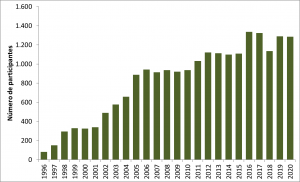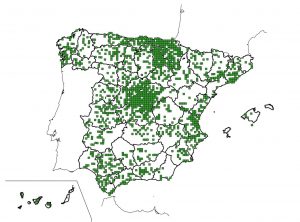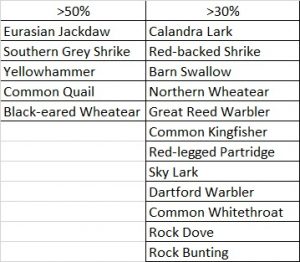25 years of Sacre
August 5, 2021
The Sacre program (Common bird monitoring in Spain) was launched in 1996, thanks to the support of the Royal Society for The Protection of Birds (RSPB). SEO/BirdLife Scientific Committee established the methodology of the survey stations that was the same used in most European countries.

In SEO/BirdLife, 12 monitoring programs are running, in addition to common bird monitoring. Some are especially aimed at the evolution of bird populations, though in winter or nocturnal birds, others at quantifying bird populations and their distribution, and others at migratory movements.
The start-up was gradual; the first year, the program was carried out in two areas covering 100 km around three areas of Spain. Then, already in 1998, after some changes, participation was opened to the entire territory, carrying out surveys in most of it.
In 2002, a network of volunteer regional coordinators was organized to collaborate in searching for new participants in their regions, reviewing the registered data, conducting courses and training sessions for participants, and proposing improvements.
In recent years, the volunteer has been offered to choose between two different methodologies: point counts or transects. This allows, in addition to complying with the reduction of the carbon footprint, increasing participation by having options according to the volunteer’s preference and the number of areas surveyed.
Volunteer participation is a key element in achieving these programs, both in Spain and in all the countries where it is carried out. Without this collaboration, it would not be possible to carry out a large-scale project of these characteristics. Since 1996, 2,688 people have registered (Fig. 1), requesting 4,124 sample units.

Fig. 1: Progress of the number of volunteers

Fig. 2: Sample units considered for the analysis of current population trends
Currently, the volunteers can record the data directly on the mobile phone at sampling and upload the data online on the web www.seguimientodeaves.org.
In 2020 Avefy was published, an app that allows training to recognize and practice with the songs of birds.
Results
The population trends of 114 bird species are considered well established, with different abundances and distribution throughout the territory (for the species population trends based on the years 1998–2020, see the table below the article).
Thanks to 25 years of monitoring birds with the Sacre program, we know, on the one hand, that 37% of the species are in an unfavourable situation in our country, and that for 26 of them (62% of those with decline), its percentage of population decline since 1998 is over 30%.
Some of these species are present in large part of the territory:
Southern Grey Shrike, Sky Lark, Calandra Lark, Common Quail, Northern Wheatear, Black-eared Wheatear, Dartford Warbler, Yellowhammer, Rock Bunting, Barn Swallow, Eurasian Jackdaw and Red-legged Partridge.
On the other hand, 44% of the evaluated species have a positive population trend.

Fig. 3: Percentage of species in each population trend category. Orange – moderate decline; blue – stable; green – moderate increase; dark green – strong increase
With the results of the analysis over a long period of years (25 years), many common species have marked steep declines in our country:

According to the analyzes carried out, the situation of birds inhabiting the four major types of habitats is very different in Spain.

Fig. 4: Progress of birds associated with different habitats
The populations of birds associated with agricultural environments are in decline, although there have been small punctual improvements in some years. The situation is unfavourable, but it is suspected that it could be even worse in the years before the samplings in Spain (1996), as has happened. There is evidence in the countries that started this type of bird monitoring program earlier. On a European scale, the decline calculated for this medium in a somewhat longer period (1980–2018) than that available for Spain (1998–2020) is set at -57%, and it is similar to in southern Europe at -34% (www.pecbms.info).
The trend for the other three large types of environments is not negative as in agricultural environments. The evolution of shrubby areas is around stability, and that of forest and urban environments is increasing. This does not mean that all the bird species found in these media have a positive trend, although most do.
Virginia Escandell and Emilio Escudero
SEO/BirdLife
We thank Martin Pelánek for providing the photos. For more pictures, visit the website phototrip.cz.




